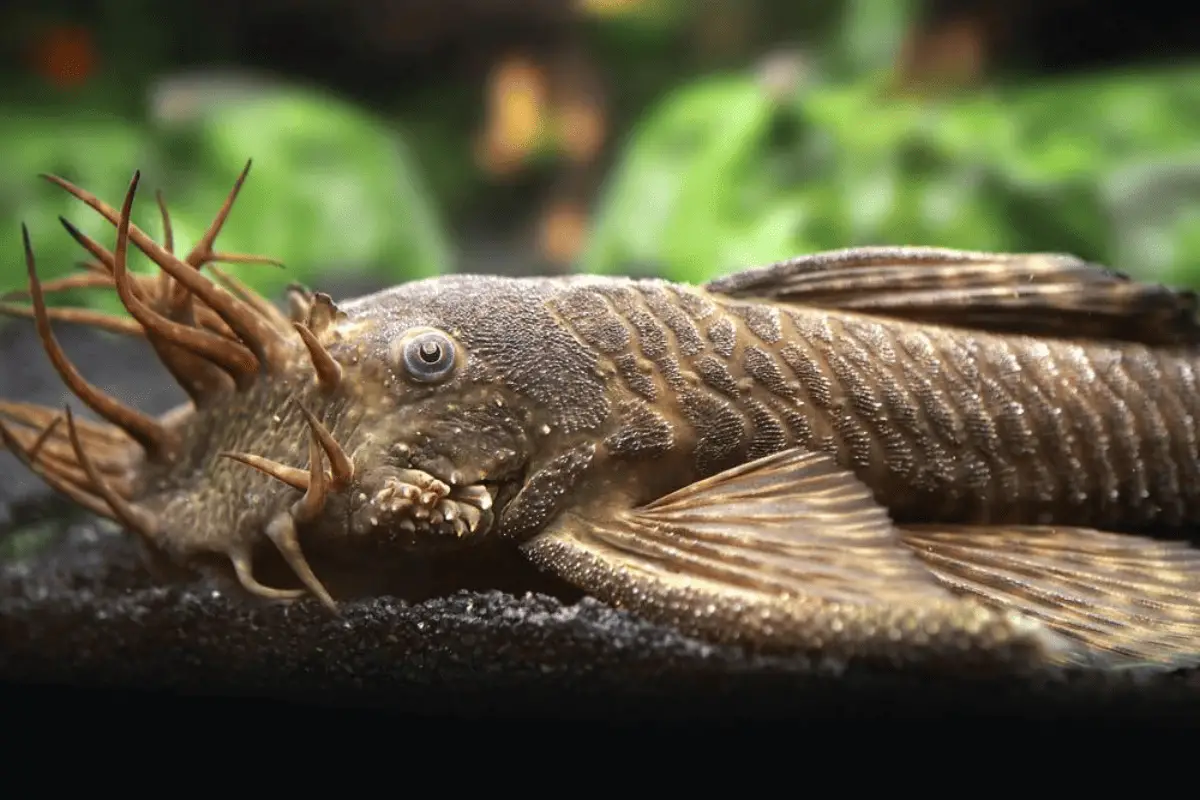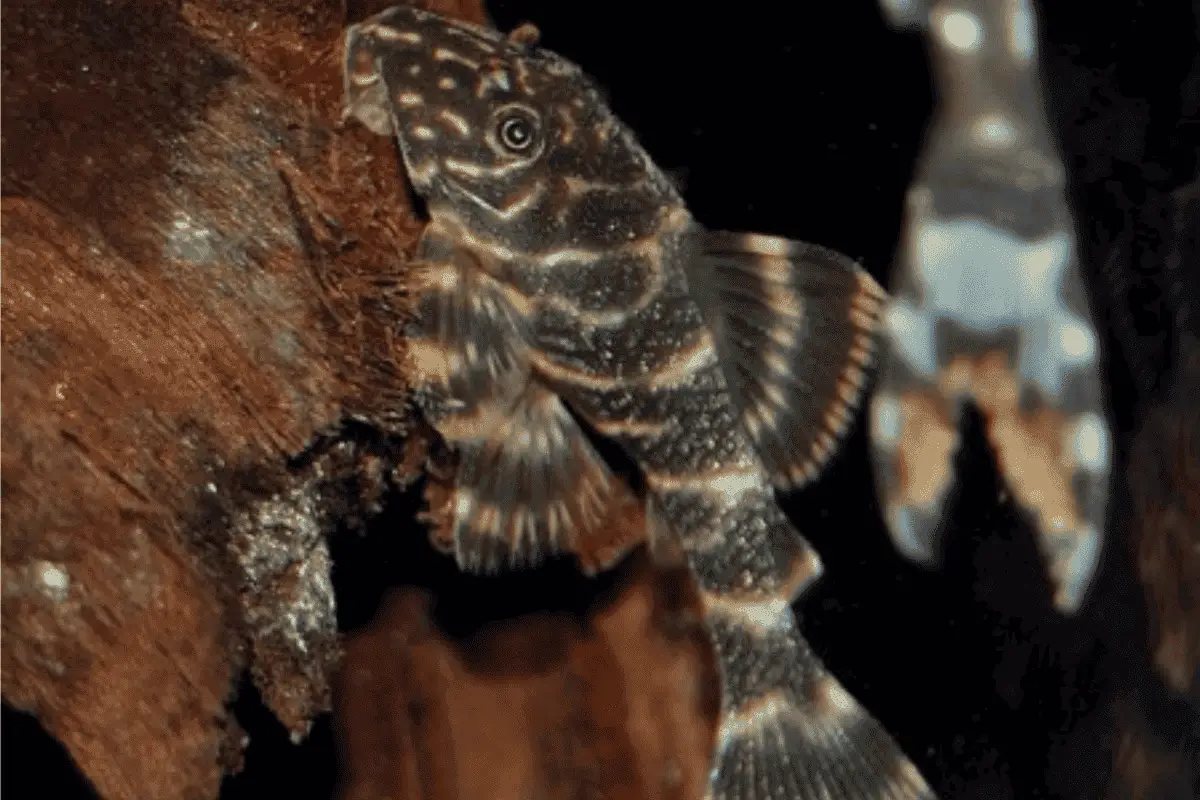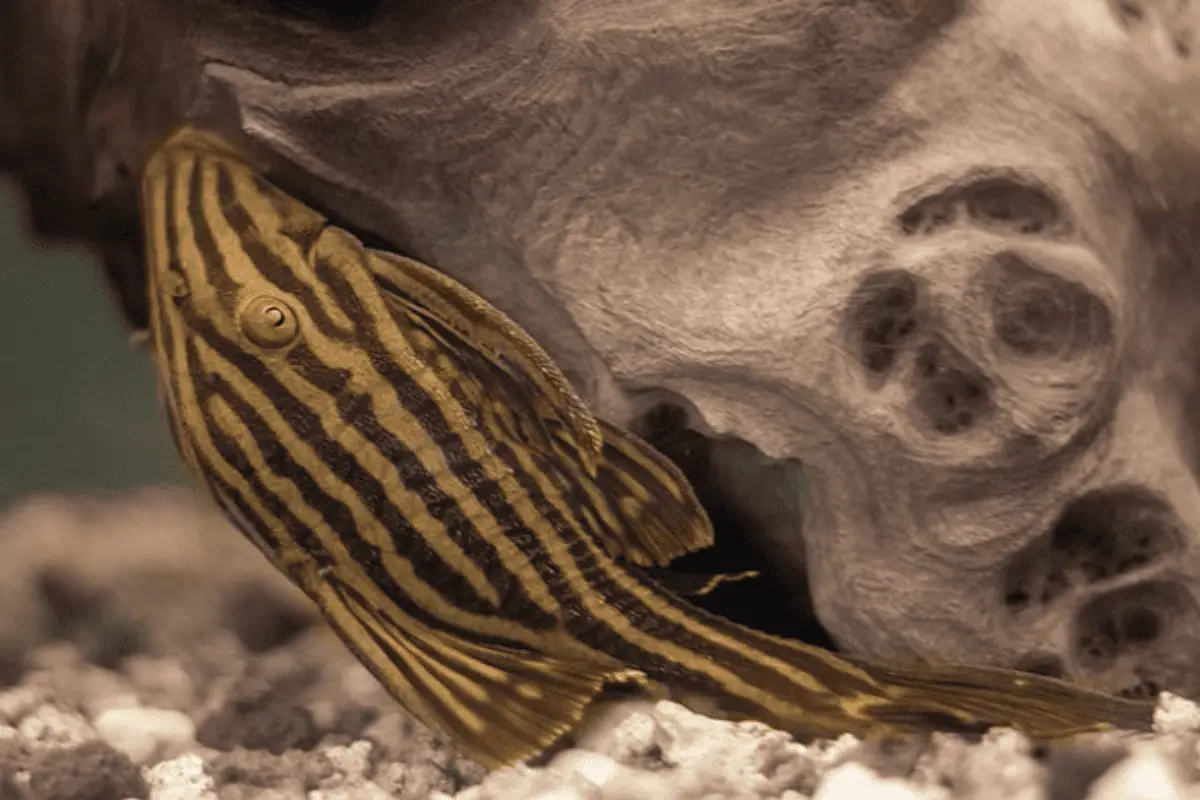Many fish owners know that Plecos are scavengers, eating almost anything they find at the bottom of the tank.
But what about bloodworms? Can Plecos consume them? Which species are more likely to eat this kind of food? And what is the right way to feed them bloodworms?
Here, I’ll discuss all these questions and many more, so you leave with all the information you need. Let’s get started.
Also Read: What Do Plecos Eat?

Which Pleco Species Eat Bloodworms?
Not all Pleco species require the same food. Here are a few common species that can be introduced to bloodworms as part of their diet:
1. Common Pleco (Hypostomus plecostomus)

The Common Pleco, a favorite among aquarists, enjoys a varied diet. While primarily herbivorous, they do show interest in bloodworms occasionally.
- Natural Diet: In the wild, Plecos graze on algae-covered surfaces, making algae a staple in their diet.
- Occasional Treats: Bloodworms can be a nutritious treat, but shouldn’t replace their primary diet of plant matter and algae.
- Size Consideration: Given their potential to grow over a foot long, Plecos require substantial amounts of food, but bloodworm portions should be moderated.
2. Bristlenose Pleco (Ancistrus cirrhosis)

Bristlenose Plecos, known for their unique appearance, are omnivores with a penchant for plant matter. Bloodworms can be a beneficial protein source for them.
- Algae Consumption: Bristlenose Plecos are excellent algae eaters, making them great for natural aquarium cleaning.
- Variety Matters: Bloodworms can be incorporated for dietary variety, ensuring Plecos receive enough protein.
- Breeding Bonus: When breeding, bloodworms can act as a dietary boost for the male Plecos guarding the eggs.
3. Clown Pleco (Panaqolus maccus)

Clown Plecos are unique, being wood-eating fish. However, they still can benefit from the occasional bloodworm treat.
- Wood Diet: A significant part of their nutrition comes from consuming wood, aiding in digestion for Plecos.
- Bloodworms as Supplements: Bloodworms can be an additional source of protein, supporting their overall health.
- Small Size: Being smaller than most Plecos, portions should be adjusted to prevent overfeeding when offering bloodworms.
4. Zebra Pleco (Hypancistrus zebra)

Zebra Plecos are carnivorous by nature, making them more inclined to consume bloodworms as a part of their diet.
- Natural Predilection: In their native habitat, these Plecos actively seek out insect larvae, making bloodworms a familiar treat.
- Main Diet: Bloodworms can be a central part of their diet, supplemented with other protein-rich foods.
- Aquarium Care: Given their specific dietary needs, Plecos of this kind thrive when given a mix of bloodworms, brine shrimp, and other meaty foods.
5. Royal Pleco (Panaque nigrolineatus)

Royal Plecos, with their striking appearance, primarily feed on wood but also appreciate supplementary foods.
While wood forms the backbone of their diet, bloodworms can serve as an occasional treat.
- Wood Consumption: These Plecos obtain nutrients by feeding on wood, which aids in their digestion.
- Protein Intake: Though wood is central, Royal Plecos benefit from bloodworms as a supplementary protein source.
- Tank Considerations: When keeping these Plecos, it’s essential to have driftwood present, but also offer treats like bloodworms for a balanced diet.
6. Gold Nugget Pleco (Baryancistrus xanthellus)

Gold Nugget Plecos are named for their golden spots and are omnivores. While they forage for algae, they also enjoy occasional meaty treats like bloodworms.
- Algal Diet: In the wild, these Plecos graze on algae and biofilm, making it a significant part of their diet.
- Meaty Inclusion: Bloodworms can be introduced as a protein-rich addition to their regular diet, ensuring Plecos are well-fed.
- Feeding Habits: These Plecos are known for being a bit shy, so offering bloodworms during quieter times can encourage consumption.
7. Rubber Lip Pleco (Chaetostoma formosae)

Rubber Lip Plecos are smaller, algae-centric catfish. While algae is a primary food source, they can consume bloodworms as a part of their varied diet.
- Algae Preference: Their preference leans towards algae, making them efficient cleaners in aquarium settings.
- Diet Diversity: Introducing bloodworms occasionally adds dietary diversity, ensuring Plecos get a well-rounded meal.
- Feeding Approach: Given their smaller size, it’s important to moderate the quantity of bloodworms to avoid overfeeding.
Here’s a simple table for 25 pleco species, categorizing whether they would typically eat bloodworms or not:
| Pleco Species | Eat Bloodworms? |
| Common Pleco | Yes |
| Bristlenose Pleco | Yes |
| Vampire Pleco | Yes |
| Queen Arabesque Pleco | Yes |
| Whiptail Pleco | Yes |
| L-204 Flash Pleco | Yes |
| Blue Phantom Pleco | Yes |
| Green Phantom Pleco | Yes |
| Butterfly Pleco | Yes |
| Clown Pleco | Yes |
| Zebra Pleco | Yes |
| Royal Pleco | Yes |
| Gold Nugget Pleco | Yes |
| Rubber Lip Pleco | Yes |
| Snowball Pleco | Yes |
| Sailfin Pleco | No |
| Medusa Pleco | No |
| Peppermint Pleco | No |
| Galaxy Pleco | No |
| Rhino Pleco | No |
| Mango Pleco | No |
| Spotted Pleco | No |
| King Tiger Pleco | No |
| Golden Line Pleco | No |
| Discus Pleco | No |
What’s the Ideal Diet for Plecos?
The food a Pleco would eat depends on whether it’s herbivorous, carnivorous, or omnivorous. Here’s what you should know:
1. Herbivorous Plecos
Herbivorous Plecos primarily thrive on a plant-based diet. In the wild, they frequently graze on algae and other plant matter.
- Algae-Based Foods: Algae wafers are a go-to staple for these Plecos. Species like the Bristlenose Pleco and Rubber Lip Pleco are avid algae consumers.
- Fresh Vegetables: Vegetables such as zucchini, cucumber, and spinach are relished. For instance, the Sailfin Pleco enjoys munching on these.
- Driftwood Requirement: Some Plecos, like the Royal Pleco, need wood in their diet for digestion and to extract certain nutrients.

2. Carnivorous Plecos
Carnivorous Plecos have a meat-rich diet, consuming insect larvae, small crustaceans, and other meaty foods in their natural habitats.
- Protein Foods: Bloodworms, brine shrimp, and daphnia are ideal protein sources. The Zebra Pleco and Vampire Pleco are examples of carnivorous species.
- Specialized Pellets: High-quality carnivorous fish pellets ensure Plecos get the nutrition they require.
- Live Foods: Occasionally offering live foods can simulate their natural hunting instincts. The Blue Phantom Pleco, for example, appreciates this.
3. Omnivorous Plecos
Omnivorous Plecos have a varied diet, combining both plant and meat sources. This diet closely replicates their diverse intake in the wild.
- Balanced Diet: Combining algae wafers with protein-rich foods is key. Common Plecos and Gold Nugget Plecos are classic omnivores.
- Fresh Foods: Offering a mix of vegetables and occasional meaty treats ensures Plecos receive all necessary nutrients.
- Adaptability: These Plecos are generally more adaptable to dietary changes. For instance, the Clown Pleco can shift its preference based on availability.

What Kind of Bloodworms Are Best for Plecos?
The best type of bloodworms for Plecos largely depends on the specific needs and preferences of each species, but in general, high-quality, disease-free bloodworms are preferred.
Fresh or frozen bloodworms are usually recommended over dried ones due to their nutritional value.
- Nutritional Content: Fresh or frozen bloodworms retain more of their natural nutrients, ensuring Plecos receive a wholesome diet.
- Safety First: Buying high-quality bloodworms from trusted suppliers minimizes the chance of bringing diseases into your aquarium. Just like other fish, Plecos can get sick if they consume tainted food.
- Digestibility: Plecos digest fresh and frozen bloodworms more easily, which supports a healthy digestive system and overall well-being.
- Sensory Stimulation: Occasionally feeding live bloodworms can spark the natural hunting instincts of Plecos, making them more active and engaged.
- Convenience Factor: Frozen bloodworms strike a good balance between nutrition and ease. However, always defrost them before giving them to Plecos to make eating effortless.
My recommendation: San Francisco Bay Brand Freeze Dried Bloodworms (link to Amazon).

Is It Okay to Give Dried Bloodworms to Plecos?
Yes, you can feed dried bloodworms to Plecos, but they shouldn’t be the main diet.
While dried bloodworms are handy for a treat, they don’t pack the same nutritional punch as their fresh or frozen relatives.
- Nutrient Loss: The drying process diminishes some of the nutrients in bloodworms, meaning they’re not as nourishing for Plecos as fresh or frozen varieties.
- Overfeeding Risk: Dried bloodworms are denser in nutrition, making it easy to overfeed and potentially causing health concerns like bloating in Plecos.
- Aquarium Pollution: If not eaten quickly, dried bloodworms can dirty the water more than fresh or frozen ones, impacting the habitat of the Plecos.
- Cost Factor: While dried bloodworms may seem cost-effective, their reduced nutritional content means you’ll need to supplement with other foods for a balanced Pleco diet.
How Do You Feed Bloodworms to a Pleco?
Feeding bloodworms to Plecos is pretty straightforward. Here’s what you should do:
- Choosing Quality: Buy bloodworms from trusted suppliers. For instance, if “Brand A” has excellent reviews among aquarists, it’s a good pick.
- Preparation: For frozen variants, thaw a cube in 50ml of tank water. This ensures they’re soft and at an appropriate temperature for Plecos.
- Quantity Control: Offer a pinch or two, depending on your Pleco’s size. A Common Pleco might eat a full cube, while a Clown Pleco needs much less.
- Feeding Technique: Use tweezers or a feeding stick. This allows precise placement, ensuring the Plecos can find the treat.
- Observation: Watch your Plecos for about 10 minutes. Ensure they’re actively consuming and check for any uneaten remnants.
- Cleanup: Remove any uneaten bloodworms after 20 minutes. This prevents water contamination and potential ammonia spikes in the tank.
How Frequently Should Plecos Be Given Bloodworms?
Bloodworms are best treated as a supplementary food for Plecos. Their frequency should be tailored to the specific species and the Pleco’s overall dietary needs.
- Common Plecos: Being omnivorous, they can have bloodworms once a week to complement their varied diet.
- Carnivorous Plecos: For species like Zebra Plecos, twice a week might be suitable since they have a higher protein requirement.
- Herbivorous Plecos: Species such as the Bristlenose Pleco should receive bloodworms less frequently, say once every two weeks, focusing more on plant matter.
- Juvenile vs. Adult: Young Plecos growing rapidly might benefit from slightly more frequent protein treats, perhaps once or twice a week, while adults may require them less often.
- Tank Conditions: In well-established tanks with ample natural food sources (like algae), bloodworm frequency can be reduced, whereas in newer tanks, a weekly treat can help supplement their diet.

What Happens When Plecos Get Too Many Bloodworms?
Overfeeding Plecos with bloodworms can lead to several health and environmental issues.
While these worms are nutritious, an excessive amount can disrupt the natural balance of the Pleco’s diet and tank health.
- Digestive Issues: Overconsumption can cause bloating in Plecos, making it hard for them to swim or even leading to more severe internal complications.
- Nutritional Imbalance: A Pleco’s diet should be varied. Over-reliance on bloodworms can result in deficiencies in vital nutrients, impacting growth and health.
- Tank Pollution: Uneaten bloodworms decompose, increasing ammonia levels. For example, in a 50-liter tank, a few uneaten cubes can spike ammonia significantly.
- Behavioral Changes: Plecos might become less active or show signs of stress, such as erratic swimming or hiding more frequently, when their diet isn’t balanced.
- Increased Risk of Disease: Ammonia spikes from decaying food can weaken a Pleco’s immune system, making them more susceptible to illnesses or infections.
Also Read: Do Plecos Eat Fish Poop?
Conclusions
For those of you in a rush, here’s a short summary:
- Pleco species vary in their dietary preferences, with some, like the Common Pleco and Bristlenose Pleco, occasionally enjoying bloodworms as a nutritious treat.
- Bloodworms can be a valuable protein source for certain Pleco species, such as the Clown Pleco and Zebra Pleco, complementing their primary diets.
- The type of bloodworms given to Plecos matters; fresh or frozen bloodworms are preferred for their higher nutritional value and digestibility.
- While dried bloodworms are acceptable for Plecos as occasional treats, they lack some of the nutritional benefits of fresh or frozen options and can lead to overfeeding.
- Careful moderation is essential when feeding bloodworms to Plecos, as overconsumption can result in health issues and tank pollution, underscoring the importance of a balanced diet.
